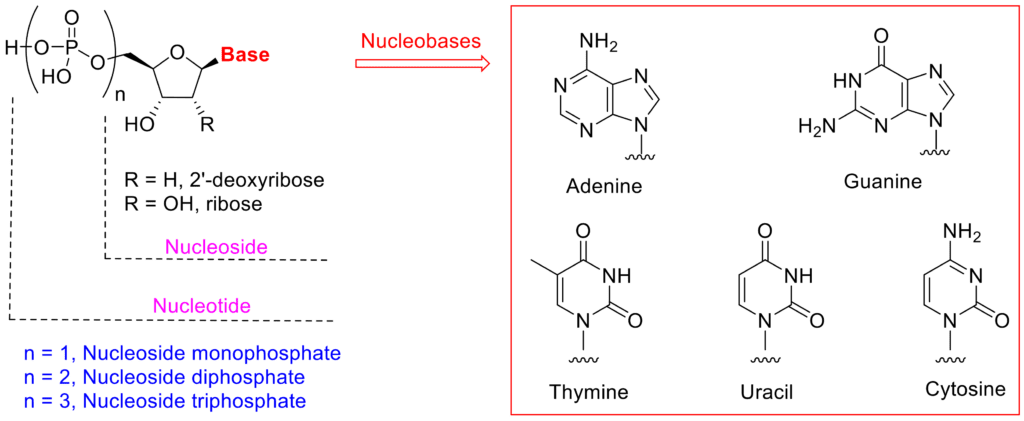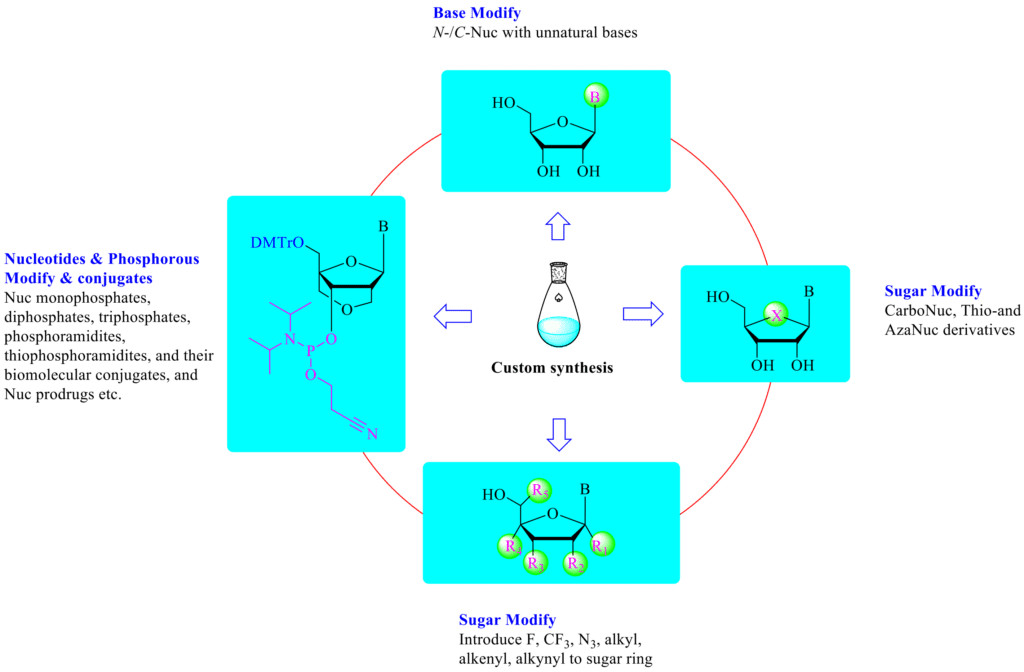Nucleic acids (DNA) are the carriers of genetic information. The central dogma depicts that genetic information (genes) stored in DNA are transcribed into RNA which are then decoded to translate into proteins. A nucleic acid is an oligonucleotide sequence that is formed by polymerization of nucleoside monomers via a phosphate bridge. A typical nucleoside consists of a sugar moiety and a nucleobase moiety which are linked via a glycosidic bond.
Since the 1950s, extensive modifications of the sugar and the nucleobase moiety led to the identification of plenty of modified nucleosides with interesting antiviral potency, and dozens of nucleoside-based antivirals have been approved for the treatment of fatal viral infections, such as HIV, HBV, HCV, HSV etc. For instance, AZT became the first modified nucleoside therapeutics to fight HIV, and nucleos(t)ides-based cocktail therapy has turned HIV infection into a chronic disease, and Sofosbuvir, a HCV NS5B polymerase nucleotide inhibitor, led to the cure of HCV infection. Additionally, oligonucleotide therapy has attracted extensive attention in drug discovery and development due to its unique mechanism of action (MOA) on gene expression.
Unlike traditional small molecule therapeutics, oligonucleotides (ODNs) act on mRNA level and control the target gene expression by upgrading, downgrading, or degrading the targeted mRNA. Oligonucleotide therapeutics includes siRNA, microRNA, antisense ODN and mRNA vaccine etc., depending on the different MOA. The major hurdle for developing ODNs therapeutics is the challenging delivery to targeted cells, tissues and organs, as well as the stability concerns in circulation. The development of modified ODNs with improved stability and the advanced delivery technology such lipid nanoparticles, GalNAc conjugation and viral vector has successfully made a couples of ODN-based drugs on market. For instance, Patisiran is a siRNA therapeutics that was approved for the treatment of polyneuropathy with hATTR amyloidosis in 2018. And Givosiran is another siRNA drug approved for hepatic porphyria (AHP) in 2019.
One of the biggest breakthroughs in this field is mRNA vaccines against Covid-19 developed by Moderna and BioNTech in 2021. The modification strategies and advanced delivery technology have made mRNA vaccines and other ODNs-based therapeutics become the research hotspot in drug discovery and development. Modification of the sugar moiety and the nucleobase moiety, as well as the phosphate backbone, can significantly improve the chemical / enzymatic stability and modify the immunogenicity of ODNs.

- Carbocyclic, thio- and azanucleosides and nucleotides
- Nucleoside and nucleotide prodrugs and their conjugates
- Modified nucleosides and nucleotides with modification on the sugar and the nucleobase moiety
- Modified nucleoside monophosphates, diphosphates and triphosphates
- Modified nucleoside phosphoramidite monomers for oligonucleotides (ODNs) synthesis
- mRNA monomers and modified cap analog
- Customized synthesis from mg to kg scale
At ChemPartner, we have developed extensive expertise in nucleosides, nucleotides, and nucleic acids chemistry over the last 15+ years. Our specialized team of 80+ chemists have well-established synthesis for 250+ nucleousides with potent antiviral activities as well as the synthesis of:

